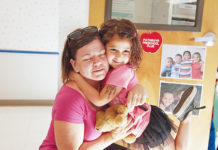
Back to school is a great time to combat childhood obesity. Exercise, good nutrition, and a back-up vitamin plan help kids embrace a healthy, active lifestyle.
Children today face unique challenges to their health. Technology and advertising are just a few factors that contribute to an increasingly obesogenic environment—a social and physical world that makes unhealthy choices easier to make. Simple lifestyle changes can prevent excess weight gain, and let kids be healthy kids.
A growing problem
During the 1980s and 1990s, childhood obesity in Canada tripled from 5 to 15 percent. Today, almost one-third of children are overweight or obese. How did this happen so fast? Genetics play a very small part. Instead, this growing problem is linked to rapid changes in lifestyle and environmental factors—at home, at school, and in the community.
Diet and exercise are key issues when it comes to childhood weight management. But is there more to it than this?
According to Dr. Casey Gray, project manager for the Healthy Active Living and Obesity Research Group in the Children’s Hospital of Eastern Ontario Research Institute, “We often talk about energy in versus energy out, but we now know that the problem is a lot more complicated.”
Emerging issues in the battle against childhood obesity include access to technology, which could lead to more sedentary time; evidence that poor sleep patterns alter metabolism and appetite; and overprotective parenting and regulations, which hinder opportunities to play.
Sedentary time
Regular activity keeps kids healthy. Only 7 percent of children in Canada achieve the recommended 60 minutes of moderate to vigorous physical activity—enough to get them out of breath and in a sweat—on most days. In addition, activity levels decline toward adolescence. So what are children doing in their free time?
Kids (ages five to 17) spend 67 percent of their waking hours sedentary, and half of this time is in front of a screen, either watching television, playing video games, or on a computer. This is a long way from the two-hour maximum screen time for protecting against weight gain. But with increasing access to social media and a generation that is more computer-literate than ever before, getting kids away from their gadgets is a tremendous challenge for parents.
The dangers of advertising
Minimizing television viewing is especially important to reduce sedentary time, but also to prevent exposure to advertisements targeting children’s peak viewing times. On average, five food-related commercials are aired per hour, most featuring junk foods. Rates of childhood obesity increase as television viewing does, and diet is influenced by what kids see and hear on television—and by what they are doing while they are watching it. Nearly one-fifth of daily calories are consumed on the sofa.
Getting kids off the couch
In the same way children learn to navigate a computer interface, they must develop skills such as coordination, agility, flexibility, and balance to enjoy being active. According to Gray, “Schools are a great place to intervene because kids have to go. It’s an ideal opportunity to garner an interest in sports, increase activity, and develop physical literacy, which is the knowledge, motivation, confidence, and physical competence that children need to stay active throughout life.”
Many schools are taking up physical education specialists, and classroom teachers are increasingly using activity tools in the classroom—for example, having a room of restless kids stand up and “shake it out.” However, most parents report that kids aren’t active enough at school, and only half of all schools have a fully implemented policy for achieving daily physical activity.
After-school and community activities
While the education system helps instill healthy habits, kids also look to parents for support. School-sponsored extracurricular programs can help increase activity after hours, and bridge the school-family network by encouraging parents to coach, attend, or organize. Parents can also find a variety of programs and clubs outside of school at local community or recreation centres.
Sport isn’t for every child, and there is no sense in dragging your kids to soccer practice if they don’t want to be there. Find out what other interests your child might have—even lower-intensity activities such as art, music lessons, or dance are beneficial. Time spent engaged in an interest or hobby is time not otherwise spent idle.
Just a spoonful of sugar
Just like physical activity, children’s eating patterns are complex and influenced by the physical and social environment. By the age of four, hunger is no longer a driving impetus, and kids are instead prompted to eat by cues around them, including media, friends, the lunch bell, and family routines.
Set an example
Parents play an especially important role, not just in what children eat, but also in how they eat. Set a good example around the table—enjoying dinner as a family helps protect kids against weight gain.
Make good food accessible
As with adults, the accessibility of food is crucial to what children eat. Keep the pantry stocked with healthy snacks and the fruit bowl—instead of the cookie jar—within reach.
Offer variety early on
Exposing children to variety early on will leave them open to exploring the palate, and they will be more likely to eat their greens as they grow. Give children time to develop preferences, and appreciate that these may be different from your own.
Avoid pressure tactics
Restricting foods, pressuring fussy eaters, and rewarding kids with sweet treats could inadvertently lead to weight gain—and have a lasting emotional impact.
Recognizing the problem
How do you know if your child is overweight? Establishing a weight problem is not as simple as stepping on the scales; age, height, body composition, and other developmental factors need to be considered. Most parents will over- or underestimate their child’s size, and parents who do notice a problem tend to mistakenly believe excess fat will be shed as kids grow.
“Parents look at other kids as the status quo,” says Gray, “and since the population is generally overweight, this seems to be leading them to believe their own kids are a healthy, normal weight.” Recognition and acknowledgement are crucial first steps toward ensuring your child’s health. Parents who are concerned should visit a health care practitioner for advice.
Act now for a healthy future
Obesity in childhood poses immediate risks to health, including high blood pressure, cholesterol, and diabetes. Other complications include breathing difficulties, such as asthma and sleep apnea, as well as liver disease, gallstones, and even heartburn—problems we used to associate with growing old, not growing up.
Without remedy, these ailments will persist through adulthood. Overweight children are twice as likely to remain overweight as adults, and the risk increases with age, so that nearly 60 percent of overweight adolescents do not shed pounds. This is why it is crucial to tackle the problem as early as possible.
The effects of poor weight management in childhood extend beyond physical health and can lead to emotional and social difficulties, impairing learning and academic performance. “When kids are not confident in using their bodies,” says Gray, “they may have fewer opportunities to socialize or make friends, which could impact their psychological development—it becomes an all-encompassing issue.”
Advertise a different message
Healthy habits are shaped in early childhood, and parents are under a lot of pressure to be perfect role models while juggling work and home responsibilities. One thing kids will remember—and appreciate most—is time you spent playing together.
Only 38 percent of parents regularly engage in active play with their kids. For once, let kids make the rules, and spend quality time in an imaginative game or new challenge. There is no need to schedule it in—just be spontaneous and open to play.
Back-to-school resolutions
The transition from summer vacation and back to school is a good opportunity to shift unhealthy habits. This autumn, build a routine of family mealtimes, provide balanced and healthy packed lunches, and encourage your kids to join an after-school club or activity—get involved as a volunteer or take part with them.
At home, make sure screen time is limited and watch television together, keeping snacking on the sofa to a minimum. A healthy lifestyle should be a family venture, regardless of anyone’s shape or size.
Are they getting enough … nutrition?
Overeating doesn’t guarantee kids are meeting nutritional requirements. These tips will help achieve a balance of vitamins and minerals.
| fibre | kids aged 9 to 13 need 26 to 38 g of fibre per day | whole grains are the best source to improve satiety and reduce weight, or supplement with glucomannan |
| protein | vegetarian children need 35 percent more intake to support growth | combine legumes, cereals, nuts, and seeds to balance amino acids |
| iron | should only be supplemented if a deficiency is diagnosed | boost levels naturally through fortified cereals, molasses, dried beans, and peas |
| vitamin B12 | essential for nervous system development | include dairy, eggs, and soy products, or supplement from 0.9 to 2.4 mcg per day |
| vitamin D | 400 to 600 IU (10 to 15 mcg) | through autumn and winter, top up a healthy diet with vitamin D supplements, to support calcium absorption and bone health |
| calcium | high-calcium diets are linked to lower body weight in children | from 4 to 8 years ensure 1,000 mg per day is met, and 1,300 mg per day up to age 18 |





























